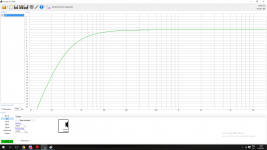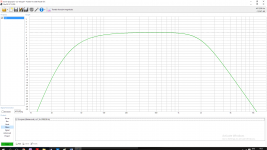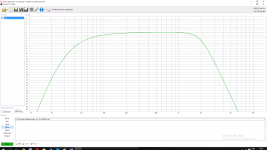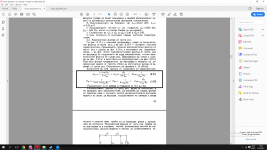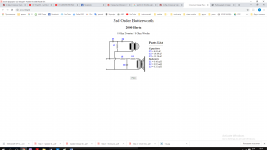Hi, I am going to make a set of 2-way speakers. This is my second project, but this time i started from zero. So I choose these drivers:
1.Woofer: MONACOR: SPH-210
2. Tweeter: MONACOR: DT-107
So the box will be with volume around 30l, poted probabbly triangal ported in 25Hz.What is your opinion ?
And I am having hard times figuring out what crossover frequency to use, the tweeter says 3000Hz but I dont realy like it, what are your sugestions?
Greetings!
1.Woofer: MONACOR: SPH-210
2. Tweeter: MONACOR: DT-107
So the box will be with volume around 30l, poted probabbly triangal ported in 25Hz.What is your opinion ?
And I am having hard times figuring out what crossover frequency to use, the tweeter says 3000Hz but I dont realy like it, what are your sugestions?
Greetings!
I'd be looking to cross that woofer at/below 1kHz, which means you'll need a different tweeter. Compression drivers might be worth a try.
How do the simulation curves look for your ported box?
Do you have any measurement equipment?
Chris
How do the simulation curves look for your ported box?
Do you have any measurement equipment?
Chris
You do not have to follow advice strictly, you can also have your own thougths. There have been produced many designs like that. You can do a little beter than that and introduce Monacor DT-300 to a Monacor WG-300.
The LF driver has a peak around 3.5kHz, which I would want to avoid by using a lower crossover frequency. Remember: the graphs are course (10dB vertical scale) and likely have some smoothing. The peak may be worse in reality!
The dip around 1.7kHz is where I'm aim the crossover - there's already the beginnings of an acoustic slope there.
That said, if you have the drivers, go for it.
Chris
The dip around 1.7kHz is where I'm aim the crossover - there's already the beginnings of an acoustic slope there.
That said, if you have the drivers, go for it.
Chris
You do not have to follow advice strictly, you can also have your own thougths. There have been produced many designs like that. You can do a little beter than that and introduce Monacor DT-300 to a Monacor WG-300.
I know I dont need to follow advice strictly, thats why I ask you. I was thinking 2 ways for crossover, one is to cut it around 4kHz and from there to 22kHz to be the tweeter, the other way is to cut it around 2kHz,but that way the tweeter will be too busy I think?
Isnt Monarco DT-107 better then the DT-300, I see the 300 has move sensity, but also is ranged up to 19kHz I lose that very highs. And like I said I already have these drivers so I need to work with them.
I can try make some carton box put the tweeter and mid and make some filters and see what please my hearing. But I am open minded for at what point is good to do it 😀😀
Greetings!
The LF driver has a peak around 3.5kHz, which I would want to avoid by using a lower crossover frequency. Remember: the graphs are course (10dB vertical scale) and likely have some smoothing. The peak may be worse in reality!
The dip around 1.7kHz is where I'm aim the crossover - there's already the beginnings of an acoustic slope there.
That said, if you have the drivers, go for it.
Chris
Okey so, its good to be around 1.5-2kHz right ?I will try somewhere there to make one crosover and hear what is sound in carton box. But that way won't be the tweeter too busy I mean the tweeter need to represent the sound from around 2kHz to 22kHz?This is a very big range of frequency ?
Greetings!
22kHz - are you a bat? very big range of frequency - not a problem, it's mainly lower energy upper harmonics. Your main problem is that at 1.5-2kHz you're getting close to the tweeter Fs, so you'll need a steep crossover to prevent distortion, and above ~2Khz the 8" woofer will start beaming....
22kHz - are you a bat? very big range of frequency - not a problem, it's mainly lower energy upper harmonics. Your main problem is that at 1.5-2kHz you're getting close to the tweeter Fs, so you'll need a steep crossover to prevent distortion, ~2Khz the 8" woofer will start beaming....
Xaxa maybe I am 😀😀 . I forgot for the Fs, okey what is your suggestion, on what frequency? I am thinking for 2nd or 3rd order crossover, its not very steep, but istn and az bad as 1st xaxa.
~2Khz the 8" woofer will start beaming..
What do you mean by that, is it good to beaming or not, because when I translate that word I cant understand what you mean?
Greetings
beaming is not good, but it's a lesser evil than tweeter distortion.
What exactly is beaming and why does it matter?
With those drivers, I'd go for a crossover at around 2 - 2.5 KHz, 2nd order on the woofer (& hope that breakup peak just below 4KHz isn't audible), and 3rd order on the tweeter.
(Actually, that's not true, I'd really make it a 3 way, but that's over-complicating things)
What exactly is beaming and why does it matter?
With those drivers, I'd go for a crossover at around 2 - 2.5 KHz, 2nd order on the woofer (& hope that breakup peak just below 4KHz isn't audible), and 3rd order on the tweeter.
(Actually, that's not true, I'd really make it a 3 way, but that's over-complicating things)
beaming is not good, but it's a lesser evil than tweeter distortion.
What exactly is beaming and why does it matter?
With those drivers, I'd go for a crossover at around 2 - 2.5 KHz, 2nd order on the woofer (& hope that breakup peak just below 4KHz isn't audible), and 3rd order on the tweeter.
(Actually, that's not true, I'd really make it a 3 way, but that's over-complicating things)
I will read the topic now for beaming, thanks.
So when I make filter with the speaker in WinISD this is what happen: you see the graph is it good at 2nd order ?
Also I have another question, when calculating the parameters to the crossover with this: 2-Way Crossover Calculator / Designer
I get the parameters shownt in the picture, but when I calculated with the book I have for building audio systems they came diffrent, I have check this calculator, with 2nd and 1st order its okey, but here I dont know.
Low cross:
L2 = 0.95 mH
L3 = 0.63 mH
C3 = 19.9 uF
High cross:
L1 = 0.159 mH
C1 = 6.63 uF
C2 = 9.95 uF
Which numbers are better, and why are there difference?
And one more quiestion, why 2nd on the woofer and 3rd on the tweeter, and not bouth 3rd ?
Greetings and big thanks to all you <3
Attachments
'why 2nd on the woofer and 3rd on the tweeter" - this is an easy way to solve the acoustic alignment problem, if the tweeter is connected out of phase
'why are there difference' - because there is more than one way to calculate crossovers, and different calculators use different assumptions (or they get it wrong) - which is why you need to understand what's going on rather than simply plugging in numbers and accepting the result....
your numbers - you have assumed that both drivers are 8 ohms, that is not the case, driver impedance varies with frequency, look at the impedance plot on the manufacturers data sheet, if there is one. The Monacor plots aren't really detailed enough, perhaps you'll have to learn how to run impedance plots yourself.
'why are there difference' - because there is more than one way to calculate crossovers, and different calculators use different assumptions (or they get it wrong) - which is why you need to understand what's going on rather than simply plugging in numbers and accepting the result....
your numbers - you have assumed that both drivers are 8 ohms, that is not the case, driver impedance varies with frequency, look at the impedance plot on the manufacturers data sheet, if there is one. The Monacor plots aren't really detailed enough, perhaps you'll have to learn how to run impedance plots yourself.
'why 2nd on the woofer and 3rd on the tweeter" - this is an easy way to solve the acoustic alignment problem, if the tweeter is connected out of phase
'why are there difference' - because there is more than one way to calculate crossovers, and different calculators use different assumptions (or they get it wrong) - which is why you need to understand what's going on rather than simply plugging in numbers and accepting the result....
your numbers - you have assumed that both drivers are 8 ohms, that is not the case, driver impedance varies with frequency, look at the impedance plot on the manufacturers data sheet, if there is one. The Monacor plots aren't really detailed enough, perhaps you'll have to learn how to run impedance plots yourself.
1. Okey so it will be 2nd on the woofer and 3rd on the tweeter. We solve that one.
2. I know there are diffrent ways to calculate corssovers, thats why i show you my formula I use. There Rt isnt impedance its load resist, is that the same as impedance?
As it goes for the plot this is what I find: MONACOR SPH-210 - 8" Mid-range
But I am not so sure is it correct. And why when I use 8oms for Rt i get 2 results that are correct with this calculators and 4 none? If we look at this graph its says at around 2kHz we have 14oms impedance
Greetins,sorry If i ask stupid questions, but i read books and forums and I am trying to lear it 🙂
This is the simplest thing you can do:
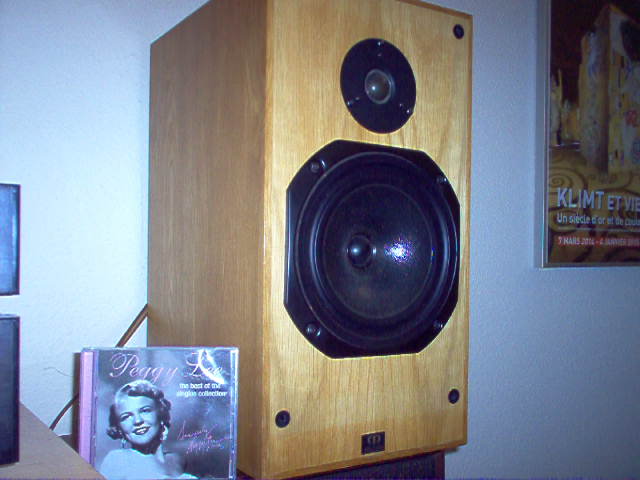
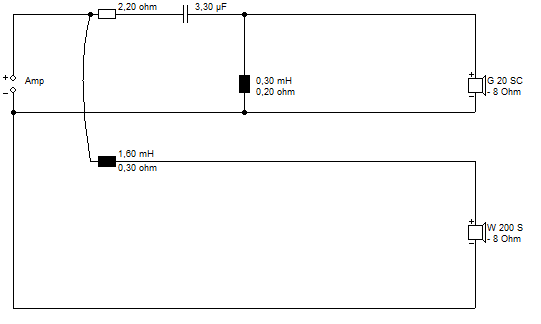
This sort of thing works better:
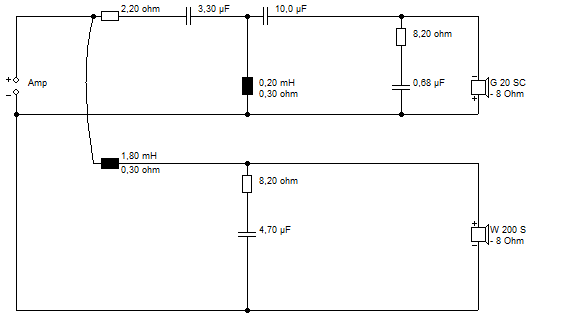
Restoring Monitor Audio R300 bookshelf speakers.
This sort of thing works better:
Restoring Monitor Audio R300 bookshelf speakers.
If you look at the SP210 graph in the link in your first post, the impedance at 2 KHz appears to be about 20 ohms, quite high. One way to deal with that is to use a Zobel network, & then you can calculate for 8 ohms (& you'll have a smaller, less expensive inductor). System7's second pic has a Zobel, the 8.2 ohm & 4.7uF cap in series on the woofer, and a similar one on the tweeter.
The Calculator page you linked above has a section on Zobels: Impedance Equalization (L-Pad) Circuit Designer / Calculator
The Calculator page you linked above has a section on Zobels: Impedance Equalization (L-Pad) Circuit Designer / Calculator
The crossover calculators assume a flat impedance. By that I mean the same impedance across the frequency range. That is not the case. Impedance varies with frequency. The nominal impedance provided by a manufacturer (8 ohms, 4 ohms) is irrelevant when choosing crossover component values.
As pete said, at 2,000 Hz, you can see the impedance of the SP210 is 20 ohms... not the "nominal 8 ohms" listed in the spec sheet. A newbie would say "ok - I'll use 20 ohms in the calculator", but that doesn't take into account the tweeter impedance and doesn't take into account the changing impedance either side of the crossover point on the woofer.
On-line calculators are crude. At best, your speaker may work ok / make noise. At worst, they could cause a very low impedance and blow up your amplifier.
As pete said, at 2,000 Hz, you can see the impedance of the SP210 is 20 ohms... not the "nominal 8 ohms" listed in the spec sheet. A newbie would say "ok - I'll use 20 ohms in the calculator", but that doesn't take into account the tweeter impedance and doesn't take into account the changing impedance either side of the crossover point on the woofer.
On-line calculators are crude. At best, your speaker may work ok / make noise. At worst, they could cause a very low impedance and blow up your amplifier.
Chris’ advice is sound, below 1000 Hz the “evil” effects of any XO start to dimisnh. Personally i like below 500 Hz and most are more like 250 Hz. This is a differnt kind of 2-way refrred to as a WAW (Woofer Assisted Wideband), where the goal is to try to get the XO below a 1/4 wavelength of the XO frequency — a place were most of the “evils’ of XOs disappear. These are usually found in the FR forum.
To get a typical dome tweeter to reach 1k typically means using. a tweeter that goes low and loading it with a “big” waveguide.
Also worth noting tha 4k is a good midbass extention to get a good match with a FR with an XO <500 Hz using a 1st order XO.
dave
To get a typical dome tweeter to reach 1k typically means using. a tweeter that goes low and loading it with a “big” waveguide.
Also worth noting tha 4k is a good midbass extention to get a good match with a FR with an XO <500 Hz using a 1st order XO.
dave
Chris’ advice is sound, below 1000 Hz the “evil” effects of any XO start to dimisnh. Personally i like below 500 Hz and most are more like 250 Hz. This is a differnt kind of 2-way refrred to as a WAW (Woofer Assisted Wideband)
Monacor SPX 20 and SPX 21 come handy to this.
The SPX 21 (VERY similar to Tang Band model...) has more excursion but it's 4Ω model, likes to be crossed 2nd order at 500 Hz
The SPX 20 likes to be crossed at 1k Hz...2nd order for max power
🙂
😱
...and different calculators use different assumptions...
To further that, online calculators almost never get you anything usable, they are only of value in suggesting a potential starting point.
dave
If you look at the SP210 graph in the link in your first post, the impedance at 2 KHz appears to be about 20 ohms, quite high. One way to deal with that is to use a Zobel network, & then you can calculate for 8 ohms (& you'll have a smaller, less expensive inductor). System7's second pic has a Zobel, the 8.2 ohm & 4.7uF cap in series on the woofer, and a similar one on the tweeter.
The Calculator page you linked above has a section on Zobels: Impedance Equalization (L-Pad) Circuit Designer / Calculator
Оkey but when I dont know the Re and Le to the tweeter how to calculate what I need? So I need to make schematic like this in the picture I draw right ?
And If we go with the parameters that the calculator says we have:
C1 = 6.63 uF
C2 = 19.89 uF
C3 = ?
C4 = 7.03 uF
C5 = 15.15 uF
L1 = 0.48 mH
L2 = 0.9 mH
R1 = ?
R2 = 8.13 Ohms
Right ?
The crossover calculators assume a flat impedance. By that I mean the same impedance across the frequency range. That is not the case. Impedance varies with frequency. The nominal impedance provided by a manufacturer (8 ohms, 4 ohms) is irrelevant when choosing crossover component values.
As pete said, at 2,000 Hz, you can see the impedance of the SP210 is 20 ohms... not the "nominal 8 ohms" listed in the spec sheet. A newbie would say "ok - I'll use 20 ohms in the calculator", but that doesn't take into account the tweeter impedance and doesn't take into account the changing impedance either side of the crossover point on the woofer.
On-line calculators are crude. At best, your speaker may work ok / make noise. At worst, they could cause a very low impedance and blow up your amplifier.
I do understand that, thas why I try to learn how to do it without them. I will use Zobel network as suggested From PeteM.And I really dont want to blow my amp 😀 thas why I as here, I know I will make it with your help and a little bit reading.
Chris’ advice is sound, below 1000 Hz the “evil” effects of any XO start to dimisnh. Personally i like below 500 Hz and most are more like 250 Hz. This is a differnt kind of 2-way refrred to as a WAW (Woofer Assisted Wideband), where the goal is to try to get the XO below a 1/4 wavelength of the XO frequency — a place were most of the “evils’ of XOs disappear. These are usually found in the FR forum.
To get a typical dome tweeter to reach 1k typically means using. a tweeter that goes low and loading it with a “big” waveguide.
Also worth noting tha 4k is a good midbass extention to get a good match with a FR with an XO <500 Hz using a 1st order XO.
dave
I dont fully understand what you mean because of the hard times with translation, but 1kHz isn't too low? I mean the tweeter resonace frequncy is higher? And istn too big range for the tweeter from 1kHz to 22kHz ?
Do you mean its good to cut it around 4kHz or not because I dont really get this sentences is it good or bad 😀 sorry 🙁🙁🙁Also worth noting tha 4k is a good midbass extention to get a good match with a FR with an XO <500 Hz using a 1st order XO.
dave

I know there are better drivers and tweeters, but this is what I got, so I need to work with these two.Monacor SPX 20 and SPX 21 come handy to this.
The SPX 21 (VERY similar to Tang Band model...) has more excursion but it's 4Ω model, likes to be crossed 2nd order at 500 Hz
The SPX 20 likes to be crossed at 1k Hz...2nd order for max power
🙂
😱
To further that, online calculators almost never get you anything usable, they are only of value in suggesting a potential starting point.
dave
I know that, but I dont have YET the fully knowledge when lower/increase the value of the coil or the capacitor its something to start with.
Greetings
Attachments
- Home
- Loudspeakers
- Multi-Way
- 2-way speakers
